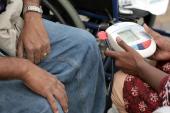Mobile Tech May Boost CAD Secondary Prevention for Older Adults
A scientific statement says data are promising, but more needs to be done to tailor effective interventions to those over age 60.

Mobile health technology may be a good way to help older adults with a diagnosis of CVD to change behavior and comply with medications, but the research into how best to accomplish this is far from clear, according to a new scientific statement from the American Heart Association.
“There are studies that are happening that are very disparate in what they're measuring, in the devices that they're using, and in the outcomes that they're focused on,” writing committee chair Erica N. Schorr, PhD, RN (University of Minnesota School of Nursing, Minneapolis), told TCTMD. Additionally, only three of the 26 studies that she and her colleagues evaluated were exclusively focused on patients over age 60, making it difficult to interpret which interventions work best for secondary prevention in older patients.
One thing they were able to gather, however, is that when older patients were included, they did just fine in terms of understanding and using the provided technology regardless of whether it was a smartphone, smartwatch, activity tracker, or something else.
Schorr added that while the research on the statement began prior to the COVID-19 pandemic, some of the things the committee learned became even more applicable in light of people being in lockdowns and under other restrictions that put distance between them and their healthcare providers.
Texts Motivate Change and Interactions
The 26 studies of mobile technology for secondary prevention examined by the committee were conducted between 2008 and 2019. Of these, 18 were randomized controlled trials and the mean age of participants was 65, ranging from 18 to 93 years. Study populations included patients with CVD, heart failure, hypertension, atrial fibrillation (AF), and PAD. Most studies evaluated feasibility, acceptance, or usability of the mobile health (mHealth) intervention being studied. Among the outcomes that were examined were medication adherence, risk factor modification, and reducing clinical outcomes such as all-cause mortality or AF. Some of the studies included assessments of quality of life, self-efficacy, knowledge, and self-monitoring behavior. For the latter, patients were asked to perform a variety of tasks as part of the interventions. Those tasks included things like recording their blood pressure, weight, eating habits, medication adherence, and physical activity, or communicating regularly with a coach or supportive network.
Schorr and colleagues found that studies that incorporated text messaging and provided resources via a website were associated with improved physical activity and other lifestyle/behavioral changes. The changes were evident after 3 months and were associated with increased medication compliance.
Successful mobile health trials that boosted compliance with therapies were found to include a mobile app or text message reminders. In one trial in which three to five texts were sent to participants per week for 6 months, 93% of the texts were read, 73% of participants said they liked the content in the texts, and 76% said the content was motivating. That study also gave participants access to a website for support, but only 64% reported using it, primarily because of access issues and poor user experience. A similar study that included a bidirectional text capability also found high rates of satisfaction, with nearly all participants responding an average of 15 times over the 6-month study period via text. Overall, satisfaction and acceptance was high among the older adult population across a variety of technologies, but several of the studies were too small to draw strong conclusions.
Schorr and colleagues say ease of use is a significant factor in the willingness of older adults to use mobile devices, services, or programs. Since not everyone over age 60 has adopted mobile technologies, familiarity and digital confidence remain barriers for some, they add. Additionally, physical limitations that accrue with age, such as hearing and visual problems, need to be considered.
“I think that people have many misunderstandings about this age group, and the concern is that they will be overlooked by researchers and even device makers,” Schorr noted. “If you want to design technology that's going to be effective for older people, then they're the ones that need to be involved with creating it.”
Another major consideration is being able to integrate information collected from mobile health programs that have been shown to be effective into patients’ electronic health records.
“Until we can get a strong body of evidence that really shows what these devices can do as far as improving health outcomes, preventing hospitalizations, or repeat hospitalizations, you aren't going to get insurers to cover it,” Schorr explained. “We’re not there yet. What we want to know fundamentally is what types of behavior changes are happening and why.”
She added that the next step “is for all of the data to go somewhere in a centralized data warehouse and for us to use data analytics to make meaningful interpretations of the data that can then be provided back to patients as well as their healthcare providers so that they can make decisions about how to move forward.”
L.A. McKeown is a Senior Medical Journalist for TCTMD, the Section Editor of CV Team Forum, and Senior Medical…
Read Full BioSources
Schorr EN, Gepner AD, Dolansky MA, et al. Harnessing mobile health technology for secondary cardiovascular disease prevention in older adults: a scientific statement from the American Heart Association. Circ Cardiovasc Qual Outcomes. 2021;14:e000103.
Disclosures
- Schorr reports no relevant conflicts of interest.





Comments